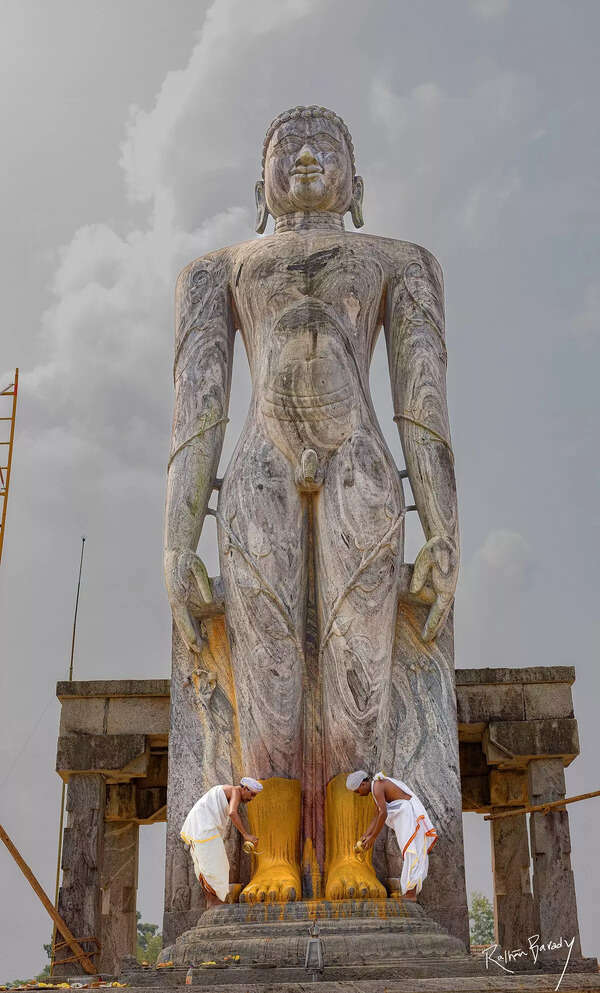Mangaluru: Karnataka's Dakshina Kannada district is gearing up for a vibrant Mahamastakabhisheka celebration of Bhagwan Shri Bahubali Swamy in
Venur
to be held from February 22 to March 1. Situated about 55 kilometres from Mangaluru, this village guarantees a lively and celebratory ambience, marking its grand festivities once in every 12 years along the picturesque banks of the Phalguni River.
The 35 feet
Bhagwan Bahubali
statue stands as an early advocate of disarmament, and his message holds significant relevance today, said Bhattaraka Charukeerthi Mahaswamiji of Jain Mutt Moodbidri. Documents with the Jain Mutt, Moodbidri reveal that
Mahamastakabhishek
for this murti was held in 1928 and 1956. The festival was not held for almost 40 years and was then resumed in the year 2000 with the support of the former union minister Late V Dhananjaya Kumar. This is the third Mahamastakabhishek (2000, 2012 and 2024) being held under the leadership of Mahaswamiji of
Jain Mutt Moodbidri
,
Dharmasthala Dharmadhikari
D Veerendra Heggade and Thimmanna Arasu Padmaprasad Ajila, Aladangady.

Bhagwan Bahubali symbolises detachment, embodying the human manifestation of penance, rigorous austerity, brotherhood and profound meditation. Bhagwan Bahubali, son of the first Tirthankara Vrushabhanatha and Sunanda belongs to Ikshvaku vamsha, possessing a remarkable physique, challenged his brother Bharata to a conflict. To avert bloodshed, they opted for resolution through 'drishti-yuddha,' 'jala-yuddha,' and wrestling. Bahubali triumphed in all, leading to a deep disillusionment with worldly pursuits. Renouncing his kingdom, attire, and ornaments, he pursued enlightenment through meditation for omniscience. After a year-long motionless meditation, recognised as an omniscient being, Bhagawan Bahubali attained liberation, said Swastishree Bhattaraka Charukeerthi Panditacharyavarya Mahaswamiji of Jain Mutt Moodbidri, adding that, Bhagwan Bahubali’s life is a contemporary inspiration, underscoring the importance of non-violence.

Dharmasthala Dharmadhikari D Veerendra Heggade said that the coastal districts boast of three Bahubali statues located in Karkala, Venur, and Dharmasthala, with Karkala being the oldest, followed by Venur and Dharmasthala. The term "Mahamastakabhisheka" is a fusion. of 'Maha' (great), 'Masthaka' (head), and 'Abhisheka' (anointing). Accomplishing a full-body anointment requires a considerable amount of water and other materials. The ongoing rituals also provide devotees with an opportunity for personal transformation. The Digambara Jaina Theertha Kshetra Samithi oversees all preparations. Conducting Mahamastakabhisheka incurs significant expenses, with devotees eager to participate, and the kalashas already being reserved. The event serves to unite the community, raising awareness and imparting knowledge about Jainism and its practices to the younger generation.

His wife Hemavathi Heggade said Karnataka has several Bahubali statues. “Following the Shravanabelagola Mahamastakabhisheka, the sequence continues with Dharmasthala, Venur, and Karkala. Despite the event occurring once every 12 years, the presence of three significant Bahubali statues along the coast necessitates substantial preparation time. Also, the statues of Bharatha, Bahubali, and Adinatha have recently been installed at Shirlal and they undergo regular Mastakabhisheka very year.
Padmaprasad Ajila, Arasa of Ajila dynasty

Venur, though now a small town, once stood as a significant seat of Jainism and served as the capital of the Ajila dynasty. The Gomateshwara statue, constructed in 1604 AD, is credited to Thimmanna Ajila. The Ajilas, belonging to Chandravamsha and Saluva Kings, initially ruled with Venur as their capital and later shifted to Aladangady. Their dynasty included the 32 villages and their descendants still reside at the Aladangady palace. An inscription from 1604 mentions the Ajilas as descendants of Chamundanvaya, possibly connected to the family of Chamundaraya, who consecrated the Bahubali murti at Shravanabelagola.
An inscription dated 1118 A.D at Venur mentions that Sevyagellarasa was the first king of this dynasty. Timmanna Ajila-I (1154-1180) reclaimed areas previously ruled by Ajilas. Following him, a king named 'Punja' governed for six years, potentially giving rise to the name "Punjalike Rajya" for Venur. Later, the Kadamba king Kamadeva conquered Punjalike Rajya, passing it to Madhurakka Devi, Timmannajila-I's daughter-in-law. Under her rule, the Ajila kingdom expanded, and she built a palace, Jain temple, and Hindu temple at Aladangady. Successive rulers continued the dynasty's prosperity, earning the name "Akkiya Ajila” (popular for the rice cultivated in the area)

Notable rulers include Timmanna Ajila-IV (1550 A.D.), a follower of Swasti Sri Charukeerthi Bhattarakha Swamiji, Shravanabelagola who consecrated the 35-feet-high murti of Lord Bahubali at Venur in 1604. The installation had historical significance, involving a dispute with the Bhairava kings of Karkala. The statue was eventually installed on March 1, 1604, and every year, the pada pooja is conducted on the 15th day of Phalguna Shuddha in honour of this sacred statue.
Padmaprasad Ajila, the current king and working president of Shri Digambara Jain Teertha Kshethra Samithi, said that presently 32 villages are included for more religious purposes, and the reverence for the king persists among the people. As a practising doctor with a clinic adjacent to the palace, he acknowledged the challenge of balancing professional commitments with religious responsibilities. However, he enjoys the support of the staff of Aladangady Aramane and the public of Ajila seeme. During every Navarathi, a durbar is convened, adhering to specific practices, and many villagers seek justice through his guidance.
On the inaugural day of the Mahamastakabhisheka, Padmaprasad Ajila, along with his wife Madhura and children Prathith Ajila and Proustil Ajila, will lead the puja. In addition to religious ceremonies, various social welfare initiatives, including medical camps, are organised, contributing to the holistic well-being of society. Cultural programmes are also held as part of Mahamastakabhishek, he said.
Darshan at Shree Siddhivinayak Temple 13 - Feb -2024












 English (US) ·
English (US) ·